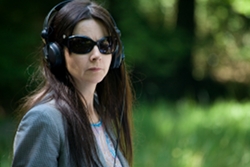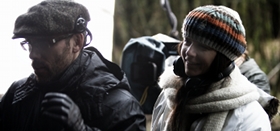GILLIAN WEARING – Director

DIRECTOR’S VISION
Self Made is about the search for authenticity in the dramatic moment, and the possibilities of creativity.
The Method workshops were designed to aid the participants, as they become the characters they have chosen. Desire to become a character and the actualization are not always in harmony, the space in between these two states is rich and interesting.
The participants found revelations in different ways during these exercises; which were not rehearsed. Sam Rumbelow kept them living in the moment, reacting as each new obstacle arose. He encouraged the cast to lay down their boundaries and not to fear. If resistance occurred, Sam helped each participant face their limitations.
The film moves a step further when the characters explore their fictional selves, sometimes resolving real life issues, other times using the space as a release. Both participant and audience experience documentary revelations, fictional constructs, and the artifice that goes in to making a movie.
I want the film to show that who the participants chose as characters is a projection of themselves, however far fetched or heinous that persona is, and that catharsis can occur through creative and playful experimentation. What does that tell us about the characters, and about society? Are these people typical of us; are we all playing a role, consciously or unconsciously?

Gillian Wearing won the Turner Prize in 1997, in recognition of her innovative work addressing public and private lives and the question of the self in society. Self Made may be her first feature film, but it is also the latest in a long series of projects that work with members of the public to ask questions about the aspects of people’s lives that they don’t always feel free to reveal. Her early work Signs that say what you want them to say and not Signs that say what someone else wants you to say (1992–93) asked members of the public to reveal something of themselves by spontaneously writing messages on paper and holding them up to the camera. Confess all on Video (1994) invited people to confess all on video, while wearing masks.
Wearing’s work is experimental both in the artistic and investigative sense: stemming from a deep curiosity about people and social conventions, it uses different media and artistic structures to enable her collaborators from the public to explore hitherto-concealed aspects of their own identities. As befits any truly experimental work, Wearing is never sure at the outset what her projects will reveal. With Self Made, she says, “The idea was always to work with people who were not actors and have them come up with an idea of who they would like to portray in a film. I wanted a ‘process’ film, in which you see someone become their character through a drama workshop. The idea was that the participant was involved in creating their character – and through this they would also discover more about themselves as they begin to think about the choices they made for the film. Even when they’re not creating a self-portrait their fictional character will reveal an element of themselves”
“A lot of my work is about creating structures in order for people to express themselves”, Wearing says. It was when drama teacher Sam Rumbelow entered the picture, after Wearing’s first auditions in 2007, that Self Made crystallized as a project. His Method approach provided the framework that would allow the group members to delve further into themselves, using techniques such as the ‘sense memory exercise’ that unlocked profound feelings in certain group members. Gillian Wearing: “I visited some of Sam’s Method classes and was fascinated how involved he got his students in workshop exercises, that they were prepared to go into these emotional states through memories and senses. In a way, it was like I imagined Method to be – but I never thought you could reach deep states from imagining having a bath or drinking a cup of tea.”

When he was asked to join the project, says Sam Rumbelow, it was immediately clear to him what questions needed to be asked. “Why and how would the Method classes fit in? What were we going to do and why were we going to do it? What are the storylines? We had to articulate what journey we were going to take with each participant. There was quite a clear notion, and for me it extended from the questions: What goes on inside? What is the mask that we present? What is real? What is fake?”
It also needed to be clear what Method really means. For Rumbelow, Method is “an approach to creativity that is rooted in the notion of exploring inner truth – a means to get beyond performance.” Derived from the pioneering ideas of Russian acting teacher Konstantin Stanislavsky, and famously associated with the work of Lee Strasberg and the New York Actors’ Studio, Method, explains Rumbelow, is often misunderstood.
“There is no such thing as Method acting because it’s not a style, it’s a body of teaching and techniques and approach. In simple terms, it comes down to what we would define as a creative state of being. That comes about when you start to work from impulse, thought and emotion, when you let go of your worldly needs and concerns and involve yourself in something more artistic and spiritual.” One of the exciting prospects for Rumbelow of working on Self Made was to collaborate with people who had no acting experience. “If people have no prior training, the bonus is they may be more willing to unlock parts of themselves that transcend a polished premeditated performance.”
The ‘end scenes’ – the culminating drama of each participant’s own experiences – were written by playwright Leo Butler and Gillian Wearing. Butler was involved in Self Made from very early on, as he explains, “It’s about getting them to live through the primal emotions that they’ve been dealing with – allowing them to enact those issues in their lives that they’ve needed to confront for many years. Whatever it is that they needed to get out of their system, they needed to do it in that scene. Whether it is being hung upside down, or knifed, they needed to live through it in that scene, because it’s the only chance they’ll get.”
What distinguishes the participants of Self Made, Rumbelow says, is that they were able to open themselves wholeheartedly to the process. “For me, it wasn’t so much the stories they told as how much they communicated them, consciously and unconsciously – how willing they were to deal with the intimate, to reveal rather than act. We could sense immediately that these people had a willingness to get involved with the self. In Self Made, most of them ran with it and were profoundly informed and affected.” For all the participants, including himself and Gillian Wearing, Self Made was an excitingly risky adventure. “Humans are fundamentally animals that respond to crisis, and crisis is when we become most creative. In a way, the film is a crisis, because we weren’t approaching it in a normal formulated way. The crisis is:
we don’t know what this movie’s going to be. That was the remit.”

Producer Lisa Marie Russo says, “Self Made grew out of the Moving Image Initiative, a programme between the UK Film Council and Arts Council England, who worked with Film and Video Umbrella to bring artists into feature filmmaking. Self Made was shot in Newcastle and was funded by UK Film Council, Northern Film & Media, Arts Council England, Channel 4 Britdoc Foundation and Abandon Normal Devices. All the financiers were excited about supporting a sensitive and perceptive artist of Gillian’s stature on her feature film debut.”
Gillian’s work often reveals revelatory moments in the lives of ordinary people, and with Self Made, these moments build towards an overall portrait of individuals who discover unexpected truths about themselves. Her quietly inquisitive nature gave the participants the confidence to go out on a limb, resulting in a unique and surprising film. What is revealed about individuals, society, performance and authenticity in Self Made results in a film that is a fascinating hybrid – at once documentary, art project, social investigation, and implicit commentary on the British tradition of social documentary.
Thanks to those intrepid participants, Self Made emerges as the latest chapter in the career of an artist fascinated with society beneath the mask – whose work has always looked deep into the hidden inner lives of real people. As Leo Butler puts it, “Gillian holds the looking-glass up to human beings – to each and every one of us – and tries to show us who we really are.”